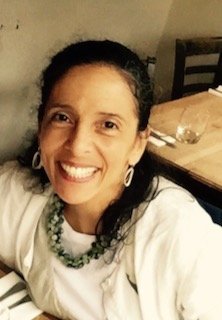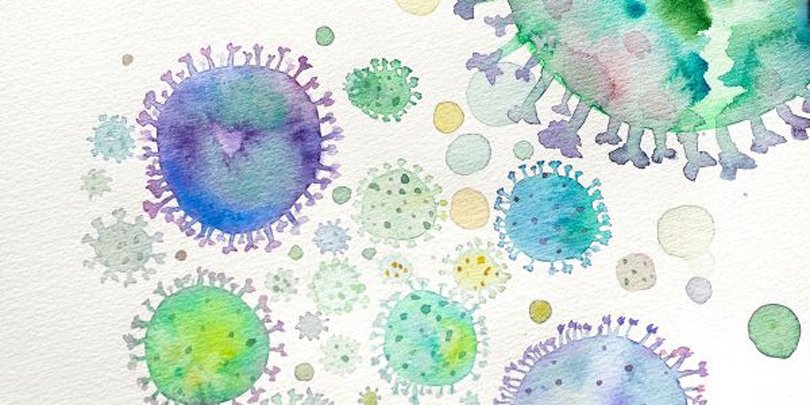Internationally renowned Art Psychotherapist Michèle Wood was interviewed by Diana Kayafa (Art Psychotherapist) about the impact of the lockdown on her daily working conditions and her views on the impact of the pandemic on art psychotherapy work.
Diana: What did you feel in relation to your daily working life when you heard there was going to be a lockdown? Worry? Relief? Anything else?
Michèle: The start to the lockdown was not very definitive and there was a lot of confusion about what you were allowed to do, and what not. The lockdown only became meaningful when I went into my university campus, in London, to collect files from my desk that I might need in the next week and saw that everything was being locked up. Staff and students access codes were changed so you could not get back into your office. That felt very strange.
As you know I also work in a hospice two days a week. There the protective measures against COVID-19 moved quickly, from the appearance of hand sanitisers everywhere in the building to the suspension of our day therapy unit. Before the social distance of 2m between people and the use of PPE was announced, the multidisciplinary team was put on a rota of those who needed to be shielded and could work from home, for example by offering telephone support. Our in-patient unit remained open and doctors and nurses were supported by representatives from the Patient and Family Support Team, who connected with the rest of the team remotely. This was a way to reduce the number of people in the building. We were all quickly finding ways to support patients, and it’s taken me a few weeks to set up virtual art therapy sessions.
On a practical level, one challenge for me was bringing my two different jobs (university lecturer and hospice art therapist) into my home environment. I normally manage these roles by having my things in two different physical locations; each with their own desks, chairs, computers, phones and books. Having two separate spaces helps me maintain the boundaries between these demanding and different roles. In addition, at home I use my office area to focus on my own studies, as I am doing a PhD in Palliative Care. Bringing everything together in my own personal space has felt overwhelming at times. It seems obvious to say - because we talk about it so much in the art therapy training - but I realised how psychologically important boundaries are.
Another challenge was accommodating to the speed and urgency of the pandemic - how to best support and maintain relationships with students, colleagues and patients; how to adjust/adapt ways of working that could keep the connection going, while also worrying about not seeing members of my family, especially my mother currently in lockdown in a care home. The internet and digital devices, such as iPads and tablet computers suddenly came into their own. Everyone has been forced online – which is really interesting for me since this is my area of research!
It is something that I've been thinking about for a long time. My Winston Churchill Fellowship in 2015 focused on this, and I continued in 2016 with a survey of art therapists’ uses of digital devices, and the live-streamed 3D Digital International Creative Arts Therapies Symposium in 2019 (www.dicats.org). Over the last five years I have been negotiating with my hospice to trial virtual art therapy groups for patients too unwell to attend the hospice. While my ideas for digital art therapy have been tolerated, progress has been very, very, very slow. However, once lockdown happened, people were asking “has Michele set up her online art therapy group yet?”!
This national experience of social distancing, fear of illness and lockdown, is giving everybody a glimpse of the restrictions faced by people living with terminal illnesses. We are living the isolation-technology issue that I’ve been thinking about for years! I am sure when we come out of this pandemic, everyone will have a story to tell about how digital technology and the internet impacted their psychological, social and physical wellbeing. This will be a rich field for all researchers.
Diana: Is this your actual PhD topic?
Michèle: My research concerns the lived experience of patients and families with terminal illnesses using digital health interventions for their psychosocial wellbeing.
Diana: There will indeed be a lot of material for you post-lockdown! My next question is, what does a typical work-day look like for you during lockdown?
Michèle: In the main, I have been following my typical 9-5 working pattern– attending meetings and teaching and delivering therapeutic services, though this is all now online. In my hospice job, members of the team are on a rota taking turns to be physically in the building or remote working from home. When in the hospice, I have to wear a mask when entering the ward, and then an apron and gloves to work in patients’ rooms. When working, from home, I offer telephone support and virtual art therapy sessions using Microsoft Teams.
One big change for me due to lockdown is lunch! There are two contrasting approaches to lunch in my different jobs. In the university, the lunch break isn’t valued as a social space. Usually I bring a prepared lunch and carry it with me as I run from one meeting to another, on the way I try to find a moment and a quiet space to quickly eat before rushing on. In the hospice having lunch is very different. It is regarded as important social downtime, where all members of the multidisciplinary team, volunteers, administrative and maintenance staff mingle and chat. There is a real emphasis on nurture, we have really nice food, and at the dining tables there is little sense of hierarchy. I miss this. However, being in lockdown at home has meant that I now have lunch with my husband, which is very nice.
Diana: That's a good meeting point. What do you value most about this new working condition, is it having lunch with your husband on a daily basis, something that you probably haven't had for many years as you've been actively working? Is there anything else that you value?
Michèle: I guess not being so tired from travelling, because as you say I am out of the house quite a lot with two jobs, and with my other professional and social activities. Being in lockdown also means enjoying being at home, appreciating where I live. I am lucky to have a garden and there is so much wonderful birdsong, now the noise of traffic and planes has diminished.
Diana: What do you miss from your previous work routine?
Michèle: Being forced to take more exercise – I usually bicycle and walk so much more than I do now. It's not as though I really relish doing the exercise, but just doing less movement means I am stiffer and achier; sitting in front of the computer is not good for the body. I now appreciate how ‘motion is lotion’! I also miss the meditative quality of bicycling, it’s a kind of unwinding for me, a psychological buffer from one space to another, allowing processing and disconnection from the emotional labours of the day.
Diana: Is that the most challenging part of your current routine?
Michèle: I think the most challenging thing is the way lockdown confronts you with yourself. It offers the opportunity to notice habits of thought, defences, unconscious behaviours. I feel being “locked in” has exposed me to myself, and on a good day that's a welcome chance to make changes. But on other days, it can be disheartening.
Diana: What is the most fundamental realization you have come to during this time about art psychotherapy or about your clients or about your role as a therapist or all of these? Has anything shifted in your thinking about art psychotherapy or your clients or students?
Michèle: That is a very big question! I hope this is a wake-up call for us to reconsider our values and ways we treat each other. The pandemic is exposing and exacerbating the inequalities in society; I hope we can address these. What is happening is also a massive relational trauma on so many levels, and words and talking won’t be enough to make sense of it all. The arts and art psychotherapy have a lot to offer.
Diana: How do you feel we might have to change what we do as psychotherapists?
Michèle: The current moment means people are responding very quickly, trying to maintain connections with clients and colleagues through technology, often with limited knowledge and skills, and little time to learn these. It's quite tempting to think very practically on a concrete level in times of crisis. In some respects, that’s how we need to think, but we also need to consider the long-term picture; the ethical implications of what we do with new technologies, how we best use them, how we set up new practices online, how we put in some boundaries that will keep people, including ourselves, and the natural environment, safe.
Diana: How would that be different from how we have traditionally thought of therapeutic boundaries?
Michèle: I don't think it will be different necessarily, but I think this global pandemic is pushing us towards a paradigm shift in health and social care. And I think for art therapists working in palliative care, we have a significant contribution to make. What the world is experiencing now is the essence of our work: anxieties and fear of death; living well and building resilience in the face of loss; grieving anticipated futures. Even if people are not directly bereaved through COVID-19, there will be those who have lost jobs, or will have to recalibrate their future plans as whole industries collapse, like those in entertainment, hospitality and travel.
Diana: It is clear that you have done pioneering work in the field of Art Psychotherapy. What would you say is next?
Michèle: I think we have to re-evaluate our relationship with money, the planet, our spirituality, how we see community, how we care for the most vulnerable members of society. I just really do hope that when we come out of lockdown, we are coming out with a much kinder and more compassionate approach to each other and the world around us.
Diana: That’s fantastic Michele, thank you so much for your time.
Michèle: Thank you for reaching all the way from Greece to speak with me. Despite us being in a time of social distancing, it’s lovely to feel connected.
Diana: It’s been lovely to speak to you.
The original version of this piece was first published in Greek for the blog of the Art & Psychotherapy Centre in Athens
https://www.art-therapy.gr/tetradia/arthra/michelewood

Michèle Wood is an internationally renowned art therapist and clinical supervisor specialising in oncology and palliative care, and a Winston Churchill Fellow. She is Senior Art Therapist at Marie Curie Hospice, Hampstead and was Principal Lecturer at the University of Roehampton London (2007-2020). Michèle's research interest is digital technologies in art therapy, focusing on applications for patients and families living with terminal illnesses.
Here recent publications include The Routledge International Handbook of Art Therapy in Hospice and Bereavement Care. Her participatory project is www.dicats.org.
Diana Kayafa is an HCPC and BAAT registered Art Psychotherapist and Clinical Supervisor with a Diploma in Integrative & Transpersonal Supervision and an academic background in psychology. She is a tutor and lecturer for the MA in Art Psychotherapy at Goldsmith’s university and for the postgraduate training programme of Art Psychotherapy at the Art & Psychotherapy Centre in Athens. She is also a Guest Lecturer for the universities of Roehampton, Hertfordshire and Guildhall School of Music & Drama. Diana’s clinical expertise lies mainly in Palliative Care and bereavement while she has worked extensively in adult mental health, mainstream and special needs education.
Copyright (c) The British Association of Art Therapists (BAAT)
This article is published in BAAT Newsbriefing Summer 2020 and may not be distributed or published without the consent of BAAT

